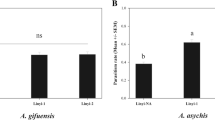Abstract
Geraniums (Pelargonium xhortorum Bailey) possess a pest-resistance mechanism, based on glandular trichomes and the exudate they produce, that has been shown to be effective against the two-spotted spider mite (Tetranychus urticae Koch). Using an intact plant bioassay, the effectiveness of the resistance mechanism was determined for another potential pest, the foxglove aphid (Acyrthosiphon solani Kaltenbach). Comparisons were made between plant lines previously analyzed for their degree of resistance to mites, as well as their glandular trichome density and trichome exudate production. Over 100 aphid adults were bioassayed on each of the five plant lines used in the experiment. In addition to adult aphid survival, the production and survival of nymphs was determined in this bioassay. The results indicate that plant lines that are resistant to the two-spotted spider mite are also resistant to the foxglove aphid, while lines susceptible to mites are susceptible to the aphids. To evaluate the physical impediment features of the trichome exudate, the behavior of foxglove aphid nymphs was compared on two geranium lines, one a resistant line with high trichome densities and large quantities of exudate and the second a susceptible line with few trichomes and reduced exudate. A third leaf surface type was produced by washing the exudate from resistant leaves using a mildly basic buffer solution prior to the bioassay. Aphid behavior was divided into five categories: feeding or probing, resting, wandering, struggling, and immobilized. On both susceptible leaves and resistant leaves from which the exudate had been removed by washing, the aphids settled quickly and were observed with inserted stylets during most of the observation intervals. In contrast, aphids on the unwashed resistant leaf surfaces often became ensnared in the sticky trichome exudate and had difficulty in settling to probe the leaf. Physical entrapment by glandular trichome exudate appears to be an important aspect of aphid resistance in geraniums.
Similar content being viewed by others
References
Craig, R., Mumma, R.O., Gerhold, D.L., Winner, B.L., andSnetsinger, R. 1986. Genetic control of a biochemical mechanism for mite resistance in geraniums, pp. 168–176,in M.B. Green and P.A. Hedin (eds.) Natural Resistance of Plants to Pests: Role of Allelochemicals. Symposium Series 296. American Chemical Society, Washington, D.C.
Dimock, M.B., andKennedy, G.G. 1983. The role of glandular trichomes in the resistance ofLycopersicon hirsutum f.Glabratum toHeliothis zea.Entomol. Exp. Appl. 33:263–268.
Duffey, S.S. 1986. Plant glandular trichomes: Their partial role in defense against insects, pp. 151–172,in B.E. Juniper and T.R. Southwood (eds.). Insects and the Plant Surface. Edward Arnold Ltd., Baltimore, Maryland.
Gentile, A.G., Webb, R.E., andStoner, A.K. 1969.Lycopersicon andSolatium spp. resistant to the carmine and the two-spotted spider mite.J. Econ. Entomol. 62:834–836.
Gerhold, D.L., Craig, R., andMumma, R.O. 1984. Analysis of trichome exudate from mite resistant geraniums.J. Chem. Ecol. 10(5):713–722.
Gibson, R.W., andTurner, R.H. 1977. Insect trapping hairs on potato plants.PANS (Pest Artic. News Summ.) 22:272–277.
Gregory, P., Avé, D.A., Bouthyette, P.Y., andTingey, W.M. 1986. Insect-defensive chemistry of potato glandular trichomes, pp. 173–183,in B.E. Juniper and T.R. Southwood (eds.). Insects and the Plant Surface. Edward Arnold Ltd., Baltimore, Maryland.
Rhoades, D.F. 1977. The antiherbivore chemistry ofLarrea, pp. 135–175,in T.J. Mabry, J.H. Hundziker, and D.R. Difeo, Jr. (eds.). Creosote Bush, Biology and Chemistry ofLarrea in New World Deserts. Dowden, Hutchinson and Ross, Inc., Stroudsburg, Pennsylvania.
Shade, R.E., Thompson, T.E., andCampbell, W.R. 1975. An alfalfa weevil larval resistance mechanism detected inMedicago.J. Econ. Entomol. 68:399–404.
Sokal, R.R., andRohlf, F.J. 1981.Biometry. Freeman and Co., San Francisco, California.
Stark, R.S. 1975. Morphological and biochemical factors relating to spider mite resistance in the geranium. PhD thesis. Pennsylvania State University, University Park, Pennsylvania.
Walters, D.S. 1988. Biochemical and morphological characteristics involved in the pest resistance mechanism of geraniums. PhD thesis. Pennsylvania State University, University Park, Pennsylvania.
Walters, D.S., Grossman, H.H., Craig, R., andMumma, R.O. 1989. Chemical and morphological characteristics of pest resistance in geraniums.J. Chem. Ecol. 15:357–372.
Winner, B.L. 1975. Inheritance of resistance to the two-spotted spider mite,Tetranychus urticae (Koch) in the geraniumPelargonium xhortorum (Bailey). MS thesis. Pennsylvania State University, University Park, Pennsylvania.
Author information
Authors and Affiliations
Rights and permissions
About this article
Cite this article
Walters, D.S., Craig, R. & Mumma, R.O. Effects of mite resistance mechanism of geraniums on mortality and behavior of foxglove aphid (Acyrthosiphon solani Kaltenbach). J Chem Ecol 16, 877–886 (1990). https://doi.org/10.1007/BF01016497
Received:
Accepted:
Issue Date:
DOI: https://doi.org/10.1007/BF01016497




